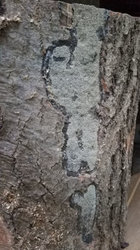I'm hoping someone can give a definitive answer on whether I need to be concerned about the mold I found growing on a red oak crotch that I was about to cut into blanks. The wood has been in a closed barn for a couple years, but the mold only appeared in the last few weeks. I don't have a problem with getting rid of the wood if it's not safe to work with, but I'd like to use it if it's not risky.




